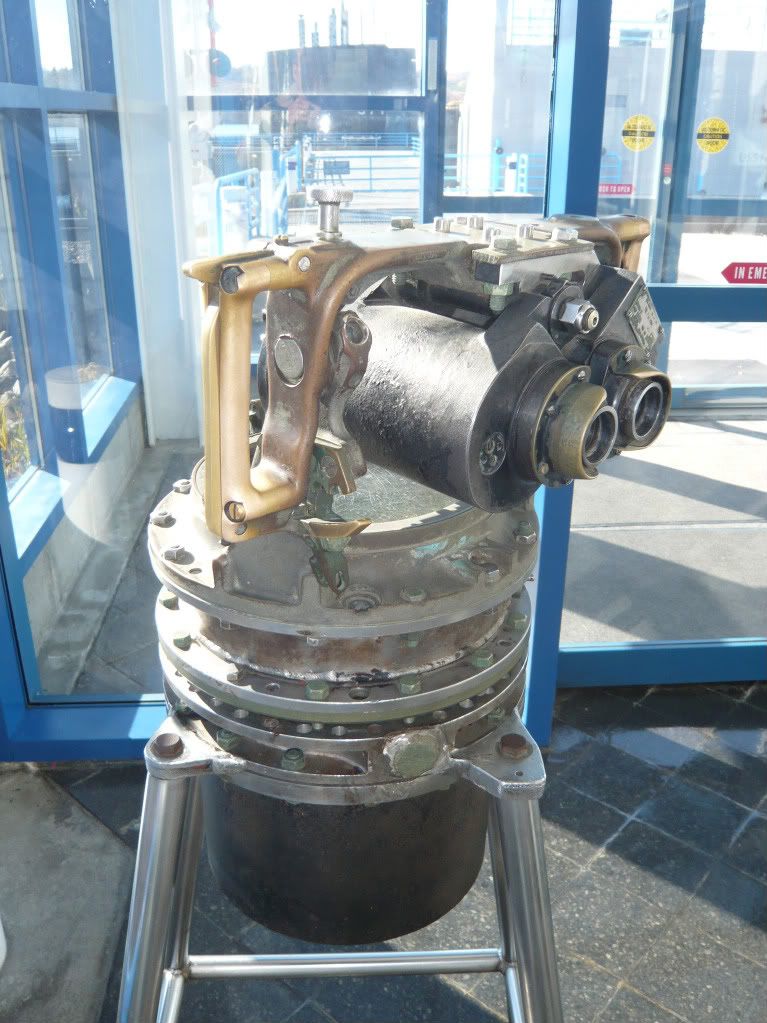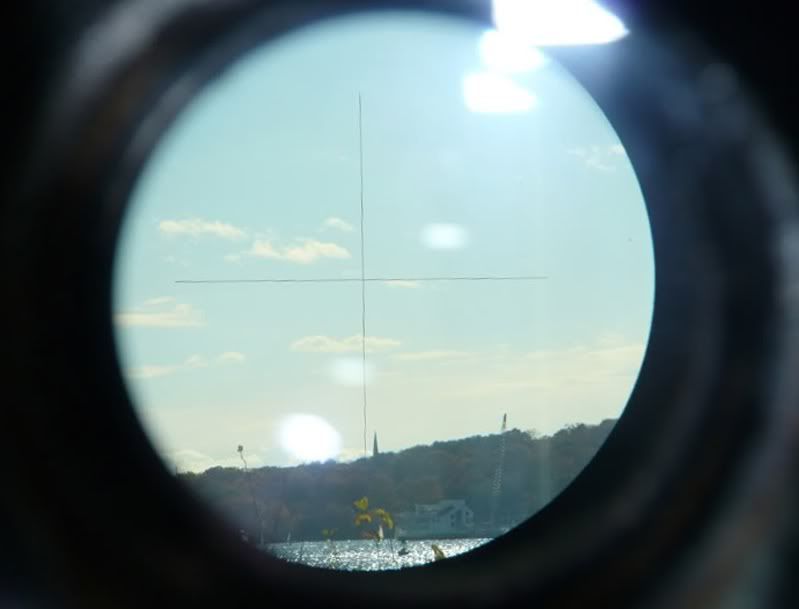
|
|
SUBSIM: The Web's #1 resource for all submarine & naval simulations since 1997
 |
SUBSIM: The Web's #1 resource for all submarine & naval simulations since 1997 |
 09-08-15, 07:51 PM
09-08-15, 07:51 PM
|
#46 | |
|
Silent Hunter
 Join Date: Sep 2010
Posts: 3,975
Downloads: 153
Uploads: 11
|
Quote:
Yes, I see your point. I kind of forgot about that aspect of the operation. |
|

|

|
 09-09-15, 09:44 AM
09-09-15, 09:44 AM
|
#47 | ||
|
Admiral
 |
Quote:
 I forget which side it was, but the stationary lines within the one lens is what you're looking at.  I don't have a picture of what the Stabilize Azimuth Line would have looked like within the Kollmorgen Periscope. Guess it was just a vertical line, separate of the Telemeter Divisions within the lens.
__________________
 The HMS Shannon vs. USS Chesapeake outside Boston Harbor June 1, 1813 USS Chesapeake Captain James Lawrence lay mortally wounded... Quote:
|
||

|

|
 09-09-15, 03:14 PM
09-09-15, 03:14 PM
|
#48 |
|
Captain
 Join Date: Aug 2009
Posts: 481
Downloads: 74
Uploads: 3
|
From the instructions on the thing, I get the impression that it is a pretty fat line too. If it was as thin as the regular lines on the optics, using one side of the line as reference would probably be a non issue in practicality I think.
I'm also pretty sure it wasn't holographic from the description. It was probably literally a plain black metal bar that would move across the periscopes eyepiece at a rate determined by the gyrocompass, periscope bearing, and submarine speed.
__________________
My SH4 LP |

|

|
 09-10-15, 07:32 AM
09-10-15, 07:32 AM
|
#49 | ||||||
|
Swabbie
 Join Date: Jan 2011
Posts: 12
Downloads: 21
Uploads: 0
|
Quote:
Quote:
Quote:
 I think, that in the view field, this line looked as on images below:   On the first image, the line was positioned at the bow of the (stationary) ship. On the second image, the periscope was moved to the left. Quote:
Quote:
-- Regards Maciek 
|
||||||

|

|
 09-10-15, 08:39 AM
09-10-15, 08:39 AM
|
#50 | |||
|
Admiral
 |
Snakedocpl, I believe your images of the Stabilized Azimuth Line are a bit misleading. The line could be placed anywhere within the periscopes Field of View. It was independent from the Telemeter Divisions........ so it was not "centered" to the FoV. You focused the line (bringing it in sharper), placing it just ahead of the targets bow, then turned the clutch "in" to engage the synchronous motor (which would have already been plugged in) just as the targets bow touched the line. Using a stop watch, you time the passage of the target. Unlike the images, there are no graduated marks, or scale for the Stabilized Line......just a line.
I'm not nit picking your help, just don't want to mislead anyone. Quote:
Quote:
__________________
 The HMS Shannon vs. USS Chesapeake outside Boston Harbor June 1, 1813 USS Chesapeake Captain James Lawrence lay mortally wounded... Quote:
|
|||

|

|
 09-10-15, 08:53 AM
09-10-15, 08:53 AM
|
#51 | |
|
Captain
 Join Date: Aug 2009
Posts: 481
Downloads: 74
Uploads: 3
|
Quote:
@scurvy You're misreading him on that first quote. He's talking about sub speed, not target speed.
__________________
My SH4 LP |
|

|

|
 09-10-15, 09:08 AM
09-10-15, 09:08 AM
|
#52 | |
|
Admiral
 |
ColonelSandersLite........

__________________
 The HMS Shannon vs. USS Chesapeake outside Boston Harbor June 1, 1813 USS Chesapeake Captain James Lawrence lay mortally wounded... Quote:
|
|

|

|
 09-10-15, 09:22 AM
09-10-15, 09:22 AM
|
#53 | ||
|
Swabbie
 Join Date: Jan 2011
Posts: 12
Downloads: 21
Uploads: 0
|
Quote:
How gyrocompass knows the ship speed? I have always thought, that it knows only its course. The speed is measured by log. The periscope manual says: Quote:
Regards Maciek Last edited by snakedocpl; 09-10-15 at 09:29 AM. |
||

|

|
 09-10-15, 09:29 AM
09-10-15, 09:29 AM
|
#54 | |
|
Swabbie
 Join Date: Jan 2011
Posts: 12
Downloads: 21
Uploads: 0
|
Quote:
-- Regards Maciek Last edited by snakedocpl; 09-10-15 at 09:36 AM. |
|

|

|
 09-10-15, 09:34 AM
09-10-15, 09:34 AM
|
#55 |
|
Captain
 Join Date: Aug 2009
Posts: 481
Downloads: 74
Uploads: 3
|
The gyrocompass needs to know ship speed in order to compensate for latitude & speed error. For the basic theory, see page 10 of the gyrocompass manual here: http://www.maritime.org/doc/gyromk7/index.htm
So yeah, the periscope is connected to the ships gyrocompass, which gets speed from the underwater log.
__________________
My SH4 LP |

|

|
 09-10-15, 09:47 AM
09-10-15, 09:47 AM
|
#56 | |
|
Swabbie
 Join Date: Jan 2011
Posts: 12
Downloads: 21
Uploads: 0
|
Quote:
Here you have got wiring of the repeaters: http://www.maritime.org/doc/gyromk7/part2.htm#pg72 There is no way to transmit speed, only the course. -- Regards Maciek |
|

|

|
 09-11-15, 06:08 AM
09-11-15, 06:08 AM
|
#57 |
|
Captain
 Join Date: Aug 2009
Posts: 481
Downloads: 74
Uploads: 3
|
Good catch, you're certainly right on that. The stabilization must have used an assumed submarine speed. Whether it was 0 knots or some other number, I see no indication of. I sort of doubt it was 0 as if this is the case, the entire system is sorta pointless as you could just use the centerline of the periscope instead.
It seems that the 89KA40/1.414 was replaced by the 91KA40T/1.414HA sometime during the war. Looking at the maintenance manual for the new model, I notice that the stabilized azimuth line function is completely omitted. No mention as to why, but I would think it was either regarded as mechanically unreliable or just not useful. That might (or just as easily might not) tie into the above uselessness of a stabilized line that does not in any way account for submarine speed. I'm not sure when exactly these replacements where made but looking at a few periscopes in surviving boats (no, I didn't check them all, just a few) the ones I saw where all the 91. I had been thinking that maybe the groups in charge of one of the surviving boats would be willing to provide a picture but I suspect that there are probably no surviving model 89s left. As an aside, it seems the "observation scope" at the start of the war was 88KA40/1.99 (a type III). Replaced by the 92KA40T/1.99 (also type III) and then the 93KN36 (type IV). Again, dates are something I don't have. Type I - Obsolete (S Boat scopes maybe? No information) Type II - Attack Scope Type III - General Purpose Type IV - Night Scope
__________________
My SH4 LP Last edited by ColonelSandersLite; 09-11-15 at 06:32 AM. |

|

|
 09-11-15, 10:10 AM
09-11-15, 10:10 AM
|
#58 | |
|
Admiral
 |
I've come to the same conclusion Colonel.
The earlier Kollmorgen periscope model had the Stabilized Azimuth Line, the 91KA40T did not. It stands to reason why there's no reference to using the Stabilized Line in the 1952 Submarine Torpedo Fire Control Manual. Also, I could find no periscope images of the Line in use. I did find an image that I couldn't resist to show  : :
__________________
 The HMS Shannon vs. USS Chesapeake outside Boston Harbor June 1, 1813 USS Chesapeake Captain James Lawrence lay mortally wounded... Quote:
|
|

|

|
 09-11-15, 11:29 AM
09-11-15, 11:29 AM
|
#59 | |
|
Swabbie
 Join Date: Jan 2011
Posts: 12
Downloads: 21
Uploads: 0
|
Quote:
-- Regards Maciek |
|

|

|
 09-12-15, 12:54 AM
09-12-15, 12:54 AM
|
#60 | |
|
Silent Hunter
 Join Date: Sep 2010
Posts: 3,975
Downloads: 153
Uploads: 11
|
Quote:
Actually, you don't necessarily need the target Aob. |
|

|

|
 |
|
|
